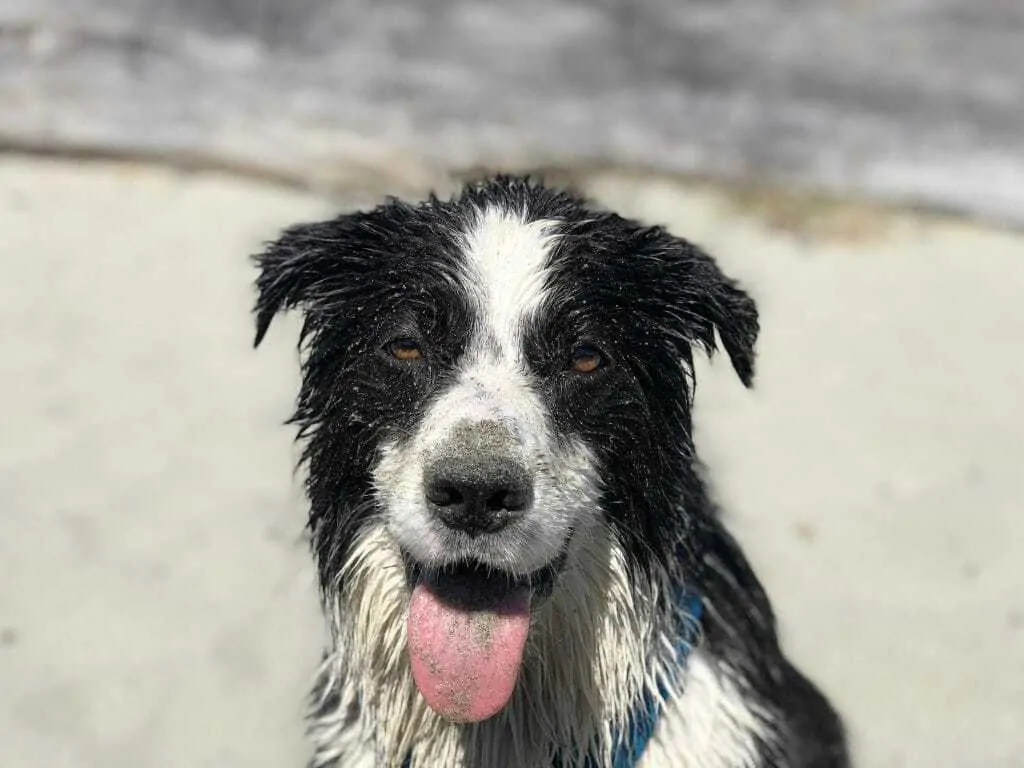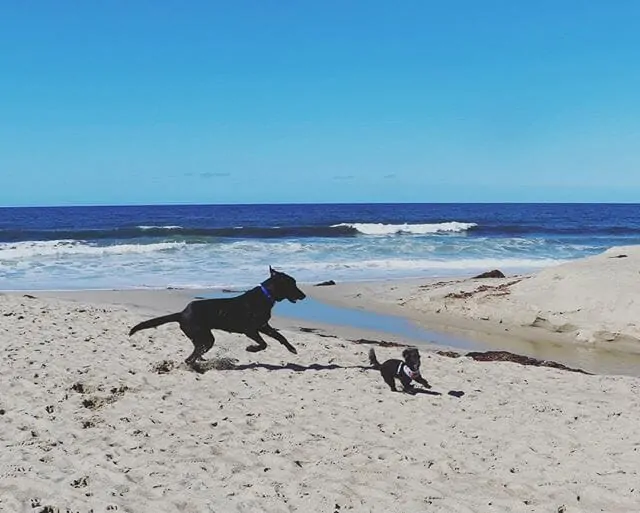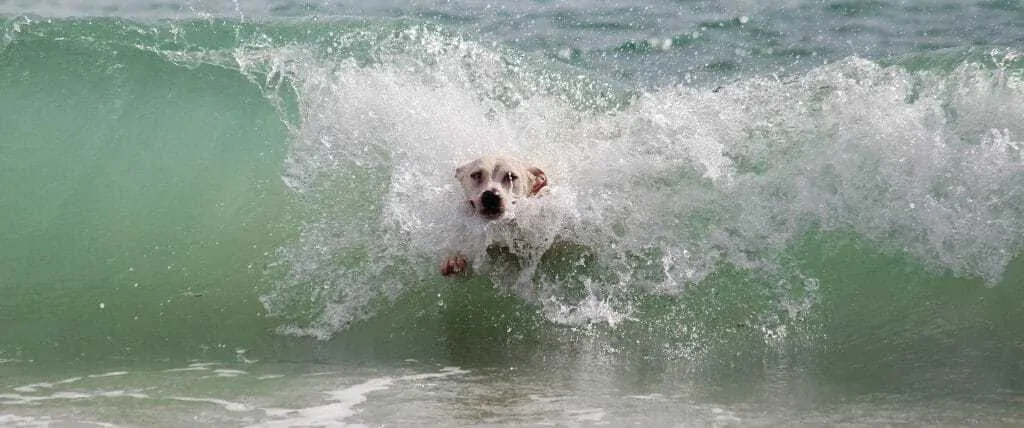Everything you need to know to keep your dog safe and happy at the beach this summer.
Beach days are a great way to take advantage of the summer sun. Like most loving dog parents, you want your pup to join in on the fun too. We get it and we’re here to help! Here is everything you need to know before bringing your furry friend to the beach.
Contents
What to Bring:
A responsible dog parent is a prepared one. Whenever you’re traveling outside the home with your pet, it’s important to have everything they need to be healthy, safe and have fun!
Here is our essential packing list to follow before you hit the beach:
- Water
- Dog bowls
- Dog tags
- Toys your dog loves to fetch
- Dog Sunscreen
- Cooling bandana
- Quick dry towel
- Poop bags
- Dog Safe eye wash
Boots, a spaniel mix, enjoying a day at the beach
Where to go:
Follow the rules
Not all beaches are dog friendly, it’s important to check your local beaches and find one that allows dogs. Even better if the beach encourages them!
Dog-friendly does not necessarily mean dog free-for-all. Even dog-friendly beaches have their own specific rules. For example, some require your pup to be on leash, others do not.
Part of being a responsible pet owner is about doing your research and making sure you adhere to local rules and laws. Lead by example and please don’t ruin it for the rest!
Check for signs indicating where dogs are allowed
Check the weather
Make sure to check the forecast before you head to the beach. Sunny days are of course preferred, but temperatures that are too high can be dangerous for a pet. Check out how to help your dog cope in summer heat.
If you’re going to the ocean, try going during low tide when the water recedes and there is more sand to run around on. You should also check things like current and wave swells to make sure conditions are safe if your dog likes to swim around. There are many apps and websites that can provide this information on your preferred beach. Surfline is a great resource.
Avoid windy days, as they can be harmful to your dog’s eyes. Sand can be blown into their sensitive eyes, which can scratch the cornea and/or cause infection. This is why we suggest bringing some dog-safe eye wash with you, in case your pup gets a face full of sand. You can rinse their eyes safely to prevent injury. Sand at a beach is, of course, inevitable but you can reduce risk by wiping your dog’s face gently with a dampened microfiber towel when they get a face full of sand.
Sandy dog
Dos and Don’ts:
Boots and Bear playing a game of chase on the beach.
DO bring plenty of water:
Water is the single most important thing to bring with you to the beach. If you forget all else, please remember to bring plenty of water and size-appropriate dog bowls for your pup. While your dog is having the time of their life running around and playing in the waves, they are working up quite a thirst. You don’t want them to start looking at that salty ocean water as a quencher. Salt water consumption by your pet can cause diarrhea and, in extreme cases, death.
DON’T let your dog roam:
Proper pet behavior at a dog beach is not unlike proper etiquette at any other dog park. Please don’t let your pup roam all over your neighbor’s towels or pee on someone’s beach chair. If your local beach allows off leash activities, only take advantage of this if you’re confident your pet has excellent recall. Your dog should obey when you call their name. Check this out if your dog could use some recall training.
DO pick up after your pup:
Always pick up after your pet when they do their business. It is proper etiquette and ensures that no unsuspecting person accidentally steps in your pet’s mess. Keeping beaches clean of dog poop can possibly mean more dog-friendly beaches in the future!
DON’T force your dog into the water:
Not all dogs like water, and some never will. Some dogs are born to swim while others are terrified of anything wet. Forcing an apprehensive pup into water can lead to a negative association for your pup, which can be hard to overcome. Afterall, there’s nothing wrong with your dog running around on the sand or doing a modest paw dip.
Dog swimming
Here are some breeds that love the water:
- American Water Spaniel
- Chesapeake Bay Retriever
- Golden Retriever
- Irish Water Spaniel
- Labrador Retriever
- Newfoundland
- Poodle
- Portuguese Water Dog
Alternatively, here are some breeds that are not strong swimmers:
- Basset Hound
- Boxer
- Bulldog
- Chow Chow
- Corgi
- Dachshund
- Maltese
- Pug
Every dog is an individual. Just because your pet breed is on the above list, it does not necessarily mean they will fall under that category. A Poodle may be terrified of the ocean and a Dachshund, notorious for their bravery, may jump right in. However, understanding your breed’s limitations is important. If your breed’s biology makes it impossible or unsafe for them to swim, practicing safety around bodies of water is of course vital. Never leave your pet unattended when at the beach!
DO encourage them to swim:
Just because your dog doesn’t jump into the water right away, doesn’t mean they can’t learn to love it. Introduce your dog to water in the same way you would introduce your dog to any new and potentially scary experience. Have patience and use positive reinforcement! Sometimes dog life vests like this one can help smaller dogs, and even big ones too, feel more secure. Here are some helpful tips for teaching your dog how to swim:
- Start by entering the water in a location where your dog can stand easily
- Allow your dog to get used to the feeling of the water while assuring them you’re by their side if they need you
- Bring treats or your pup’s favorite toy to help with this acclimation period to make them feel more at ease or distract them if needed
- Support your dog’s stomach as they get used to paddling – a life vest will help with this!
- Don’t go beyond your dog’s limits. Stay close to shore the first few lessons and lookout for signs of exhaustion or discomfort
DON’T forget sunscreen:
Many people don’t initially think of using sunscreen on their dogs, but prolonged sun exposure can lead to sun damage, especially to shaved dogs or dogs with light-colored coats. Dogs with pink skin and noses can also be at risk. A link to dog-safe sunscreen can be found in our packing list above. We recommend consulting with your vet before using any human sunscreen on your pet. However, if you do, NEVER use any product that contains zinc oxide or para-aminobenzoic acid (PABA) as they are toxic to dogs. Here are vulnerable areas you should consider applying sunscreen on your dog:
- Ears
- Nose
- Belly
- Groin area
DO play and engage:
Bring your dog’s favorite toy to fetch. Or, if you forgot the toys at home, find a nice piece of driftwood for your dog to chase. Stretch your pup’s legs- and your own! The benefit of dog beaches over dog parks is they are usually bigger with plenty of room to run and play. Take advantage, your pet will love it.
DON’T overheat:
As mentioned above, the weather is an important factor when deciding to bring your pet anywhere. However, hot days can be hard to avoid in the summer. Take precautions to make sure your dog keeps cool. Here are the three golden rules to avoid overheating in the summer:
- Provide lots of water
- Find some shade
- Use a wet beach towel or cooling bandana to keep their body temperature normal
DO HAVE FUN!
The best part of spending quality time with your beloved pet is shared fun. We hope this article will help you be aware, be respectful and have the knowledge and equipment to keep your pet safe at the beach. Beyond that, relax and HAVE FUN! Taking your dog to the beach is a great way for you both to get some sunshine and take advantage of those fleeting summer days. Enjoy!
Bear, a Great Dane/Lab mix, enjoying the sunset.






